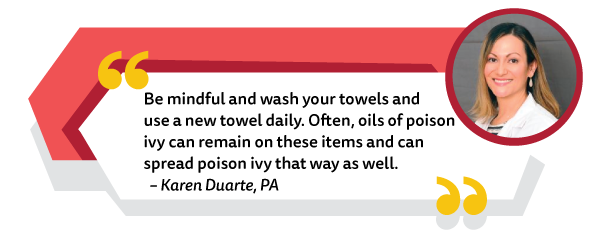With the warmth of spring and summer rapidly approaching, so is the time of year when we all venture outside. From hiking and barbecuing to sports and swimming, spending time outdoors can be a welcome relief after a winter of being cooped up in cold and dreary weather.
There are a few hidden dangers, though, to spending time outside. Aside from making sure you wear sunscreen whenever you’re out and about, some plants can cause skin rashes if you aren’t careful. Poison ivy, poison oak, and sumac can all cause painful, itchy rashes that spread wherever the plant has touched on your skin. There’s no quicker way to ruin an outing than accidentally brushing up against some poison ivy!
So what do you do if you find yourself with a rash from one of these sneaky plants? Let’s find out.
Step one: Wash immediately!
If you think you’ve touched one of these plants, act fast! Washing up quickly can make a big difference in how fast the rash spreads and sometimes can keep it from developing at all. Wash with any one of these:
- Rubbing alcohol is best if you have it handy.
- Dish soap
- Laundry detergent
There are also specialized wipes made for use against poison ivy and poison oak, but most people don’t usually have those on hand. If you know you’re going to be spending time outdoors, it might be wise to stock up on them.

Step Two: Rinse with cool water.
Soaps and alcohol are incredibly drying, so make sure you rinse off with lots of cool water and avoid skin damage of a different kind.
Step Three: Check under your fingernails!
Your fingernails can hide microscopic bits of plant matter, so make sure you clean underneath them with a brush. Even a little bit of poison ivy, poison oak, or sumac can invite breakouts in some people.
If you do this within 10-20 minutes of exposure, you may avoid a rash altogether, and doing it after that can help reduce the severity of a rash. Follow these steps while you’re out in nature, and you’ll be able to keep safe!
Accidents still happen, though, and if you develop a plant-based rash after an excursion outdoors, contact your dermatologist. They can help provide you relief and get you back to adventuring in no time!
